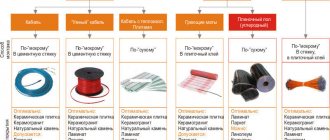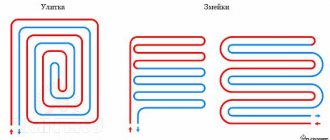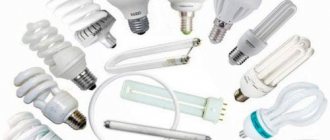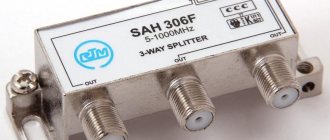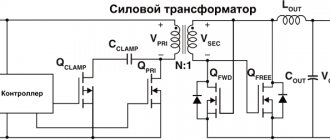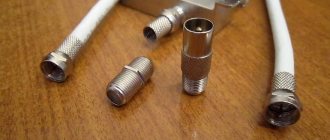Among owners of private houses, warm floors are becoming more and more popular every year. They can be either the main or additional source of heating the room.
When choosing a heated floor model for an apartment, everything is more or less clear - preference is given to electric types, since the water structure is heavy and requires connection to the central heating of an apartment building.
Choosing a heating system for a private home is more difficult, because any device can be installed. And before giving preference to any model, it is important to correctly weigh the pros and cons.
Types of electric heated floors
Electric floors are divided into three types:
- infrared – heating function based on the principle of infrared radiation;
- thermomats - the room is heated by special thin cables (single/double-core);
- cable - heating occurs using cable sections.
Types of infrared structures:
- film;
- rod-shaped
Types of cable heating:
- design for thin floors;
- heat storage system;
- direct heating;
- construction under a wooden covering.
Electric heated floor installation
Infrared film consists of two layers of polymer material, between which a carbon nanostructure (heating element) passes. The material emits infrared light, the wavelength is 5-20 microns.
The design contains carbon strips and copper bars. The width of the strip is 1.5 cm. Busbars coated with silver connect the strips and pass electric current.
On both sides, the heating element is protected by a special polymer, which protects against moisture, fire and does not block infrared light.
The infrared rod floor is manufactured in the form of numerous rods connected in parallel to each other using flexible connecting wires. Inside the rods there is a mixture of silver, carbon, and copper.
When an electric current hits carbon fiber, thermal energy is released.
Thermal mats are made using a thin cable attached to a fiberglass mesh. For protection, the heating core inside the cable is covered with a special screen, insulating material and an additional sheath.
The heating temperature is regulated using a thermostat. It is connected to the power supply network using a cold wire, the length of which is at least 2 m.
A special coupling is used to connect the heating and cold cables. The surface temperature is controlled using a thermostat and temperature sensors.
The cable floor is characterized by high efficiency levels - almost complete conversion of electric current into energy occurs.
The function of the heating element, regardless of the type of system, is performed by the cable. It is divided into two types:
- resistive;
- self-regulating.
Resistive cable can be single- or double-core. A single-core cable includes a metal core and an insulation layer. In a two-core cable, one core can perform the heating function, the second - power. It is possible to have two heating cores.
On the outside, the cable is protected by a metal braid and a screen. The amount of energy released by a self-regulating cable varies depending on the ambient temperature. Heating cable is supplied in reels, rolls and sections.
Heating includes thermostats that regulate temperature and temperature sensors designed to gain knowledge of environmental conditions for efficient operation.
Electricity consumption calculation
Electricity consumption calculation
The operating principle of underfloor heating is to convert electrical energy into heat with high efficiency (up to 99%). At the same time, the consumption-emission ratio remains almost equal to 1 to 1 (100 W of electricity to 99 W of heat).
Thus, the indicated underfloor heating power of 250 W per square meter means that 1 m2 of underfloor heating will consume 250 W of electricity.
With additional heating per 1 m3, depending on the type of room, the following thermal power is provided with a large margin:
- Residential premises - 180 W
- Kitchen – 120–140 W (on the 1st and 2nd floors, respectively)
- Bathroom – 150 W
- Balcony – 170 W.
Infrared film heated floor
For standard rooms with a ceiling height of 2.5–3 m, the thermal power is 130 W for the cable and 170 W for the mat, taking into account the margin. A room of 50 m2 will consume approximately 500 kW per hour.
In fact, only 60–65% of these indicators are consumed, the thermostat saves another 35–40% of energy. It turns out that in order to calculate the thermal power of each room, it is necessary to multiply the volume of the room in m3 by the average heat consumption of 40 W.
It is worth considering that the system usually does not operate around the clock, but 8–10 hours a day. The amount of energy consumption also depends on the set heating temperature.
When the room heats up to a certain degree, the thermostat turns off the floor, and when it cools down, turns it on again. The profitability of a heated floor depends on the duration of such on-off cycles and is higher, the higher the insulation of the room.
Characteristics
The infrared floor kit consists of film, installation wires, contact clamps, bitumen insulation, documentation (installation manual, passport, warranty).
Technical characteristics of film infrared coating:
- length – 50 m;
- width – 0.5-1 m;
- thickness – 0.23-0.47 mm;
- temperature – 31°C;
- power consumption 1 m² – 25-35 W/h.
Technical characteristics of rod infrared coating:
- maximum length – 25 linear meters;
- width – 0.83 m;
- distance between rods – 0.10 m;
- temperature – 28-31°C;
- power consumption – 24 W/h.
The heating mat is supplied with a thin mat, equipped with a cable with a high-temperature insulating layer, a mechanical regulator with a temperature sensor, a corrugated tube, and documentation.
Technical characteristics of the thermomat:
- thickness – 4.5 mm;
- width – 45 cm;
- maximum heating element temperature – 90°C;
- power consumption 80-220 W/h.
The cable device kit includes a heating element, a temperature sensor, a thermostat, fasteners, documentation, including an installation diagram and instructions.
Technical characteristics of cable heated floors:
- maximum heating element temperature – 65°C;
- thickness – 7.5 mm;
- power consumption – 110–200 W/h.
Cable heated floor
The heating element here is a special cable that converts the electricity passing through it into heat. Moreover, in cable heating elements there can be different cables: single-core, double-core or self-regulating:
- A single-core cable includes a single heating filament, its ends are brought together during installation and one of them is connected to the phase current-carrying wire, and the second to the neutral wire.
- A two-core cable contains two threads, so its installation should not be reduced to a loop, but use a “dead-end” installation method.
- A type of two-core cable is a self-regulating cable, which is able to regulate the degree of heat generation in its different sections. It is often used to protect pipes from freezing and in snow melting systems.
- A heating mat is a single-core or two-core cable that is fixed to a mounting grid with a certain pitch. Its advantage is that it can be embedded not only in a concrete screed, but also in a layer of tile adhesive in the bathroom, if this is the finishing coating used there. Thanks to this, you can reduce the thickness of the floor in the bathhouse and speed up the installation process.
Electric floor heating systems based on cable heating elements are good because they can conveniently create any configuration of the heating zone (heating mats, alas, cannot boast of this).
Any cable structures heat up quickly (in 10-15 minutes) and are capable of continuously releasing heat for 4-6 hours.
It is best to install cable systems under any stone covering (porcelain tiles, ceramic tiles, etc.).
pros
Infrared is energy efficient because it converts radiated energy into heat. The design is more economical compared to cable systems. The surface heats up within a few minutes.
In case of mechanical damage, only the failed segment of the structure loses its functionality. The remaining system continues to operate as usual. The room is heated evenly.
The coating is not subject to corrosion processes and is fire resistant. It is possible to use the film in rooms with increased load on the floor covering (in public places), and use the material as a wall heat source. Other benefits:
- Quick installation due to the absence of additional work. Installation takes no more than 1 day.
- Operation is possible immediately after installation.
- Installation of the structure on any floor covering without preliminary preparation and screeding of the base.
- Using a thermostat adjusts the temperature in the room.
- Heating the air using infrared radiation is not accompanied by a change in humidity levels.
- IR radiation does not harm the human body, but on the contrary, produces a healing effect.
The use of heating mats saves the height of the room, since installation requires no more than a few centimeters. The thermomat uses electrical energy economically. There is no need for installation under large household appliances or furniture.
The mats feature simple installation technology. Other benefits:
- Rapid heating of the floor covering due to its close location to the surface;
- Thickness (3-4 mm);
- Uniform heating of the room;
- No harmful radiation;
- Environmental safety of the materials used;
- Corrosion resistance.
The cable device is mounted directly into the screed, so it does not take up free space. During its service life, the structure does not require additional maintenance. Does not generate dust during operation.
The design does not use substances that cause allergic reactions. Other benefits:
- Involves setting and maintaining the required temperature conditions.
- Thanks to thermal sensors, the heated floor receives information about the environment and reacts to changes in it.
- Does not require the use of additional devices.
- It has a long service life, safety and reliability.
General benefits:
- Installation in public areas.
- Structural elements are not visible under the floor covering and do not affect the design of the room.
- The temperature regulator adjusts the automatic switching on and off of the heating.
- Used as the main or additional source of heating.
- Simple and quick installation that does not require special knowledge or equipment.
- Long service life.
- Uniform heating over the area.
- There is no need to install additional equipment to start.
All about water systems
Before choosing one of the two popular systems, you should get acquainted with the features of each.
Operating principle and design features
A water-type heated floor is very easy to install. Under the finishing floor covering, pipes are laid in the form of a closed loop, through which the coolant is run. Depending on the type of heating system, this may be an antifreeze solution or water, etc.
Considering that the length of such a circuit is usually quite large, a circulation pump must be present.
It will provide the liquid with the necessary circulation rate. Two methods can be used to heat the coolant.
Option number 1 . Receiving hot water from a centralized system. You must understand that this can only be done by obtaining permission from the heat supply company, with the installation of additional equipment. For illegal connections, heavy fines are imposed and dismantling is carried out.
A warm water floor system is a liquid heating circuit installed under the floor covering. It is preferable to choose plastic pipes for installation
In practice, this option is used extremely rarely. In addition, it is only permissible in the first floors of multi-storey buildings due to the impressive weight of the floor with screed, for which the floors were not designed, and because of the likelihood of leaks and an overly costly, complex emergency response plan.
Option number 2 . Connecting the system to the heating boiler. There are subtleties here too. SNiPs prohibit heating floors above 30ºС, so the coolant temperature cannot be higher than 35ºС.
Standard boilers heat the liquid to higher temperatures, on average up to 65-95ºС. Therefore, additional equipment will be required to reduce the coolant temperature.
For these purposes, a so-called mixing unit is used, in which the hot liquid is mixed with the cold liquid coming from the return pipe.
An exception is condensing type boilers. These devices are capable of heating the coolant to small values, which is ideal for heated floors. In this case, installation of a mixing unit is not required.
The coolant for a water floor is most often heated by a boiler. In this case, the installation of additional equipment is required - a mixing unit. Here the heated liquid will mix with the cool “return”, otherwise the floor will overheat (+)
For comfortable operation of the water floor, a temperature regulator is provided, working in conjunction with temperature sensors. The latter are placed in a heated room at a certain height. The information received from them is analyzed by a thermostat, which in turn controls the degree of heating of the coolant.
A more convenient option is to equip each of the collector inputs with thermostatic regulators.
Nuances of system installation
A water-type floor can be arranged in several ways. Each of them is quite complex and expensive.
Option number 1 . The most common method is to use a screed. In this case, it is assumed that thermal insulation is first installed on a leveled base. This is a mandatory point; if it is ignored, some of the heat will go down, heating the basement.
Thus, the heating fee will be higher than necessary. The insulation thickness is calculated individually for each room.
Be sure to use additional insulation around the perimeter of the room. Damper tape or tape insulation is placed here. This is necessary to prevent heat loss through the walls and prevent the appearance of cracks due to thermal expansion.
Traditional technology for installing a water floor involves laying it in a screed using the so-called “wet” method. The resulting heated floor “pie” should look something like this (+)
The pipes are laid directly on the thermal insulation. There are several mounting options: on a mesh reinforcing screed, on fastening tapes, on a special substrate. Next, the solution is poured. This is concrete to which additives have been added to increase thermal conductivity.
The thickness of the screed should be such that there is at least 3 cm of compound above the pipes. Next, it takes time for the concrete to dry and gain strength. On average, this is at least 28 days. During this time, using heated floors is prohibited.
Among the disadvantages of this method of arranging the system, the most significant can be identified:
- large mass , which puts a significant load on the carriers;
- low maintainability - in case of a leak, you will have to dismantle the floor covering and break the screed;
- significant height - on average, taking into account the insulation, the water floor has a height of about 9-10 cm, which significantly reduces the height of the room.
Option number 2 . The so-called flooring system. In this case, the pipes are laid without using a screed. Special plates are used to form the structure. They can be made of polystyrene or wood.
Grooves are formed on the sheets into which it is convenient to lay pipes. Considering that the material has low thermal conductivity, the plates must be supplemented with metal elements.
A flat-type water floor is easier to install, especially if you use polymer mats for laying pipes. They must be equipped with metal elements to increase the thermal conductivity of the base
The topcoat can be applied directly to wood sheets. In the case of polystyrene, an additional solid base for finishing will be required.
This installation method is less labor-intensive and expensive. An additional plus is that the flooring system can be laid on wooden floors, since its weight is low. In general, installation of water heating is quite complicated.
Why choose a water floor
In general, heated floors are a very effective way to heat a home. The temperature distribution with such heating is very favorable for humans. The air warms up evenly, with the warmest zone being formed in the lower part of the room, and a little cooler at head level.
There are no convective currents characteristic of the use of spot heating devices that carry dust and microorganisms.
Water floors can be used as an additional or as the main source of heat. For relatively warm regions, the second option is preferable. For areas with harsh climates, the first choice is the best choice. The main thing is to pre-calculate the system, correctly determine the diameter of the pipes and the laying pitch.
In addition to high efficiency, it allows you to significantly save on heating. If two heating circuits are laid from the boiler, the heated liquid will first go to the radiators.
One of the best options for using underfloor heating is when there are both radiators and a water circuit under the floor. This is the best option for heating in cold regions
After it has cooled a little, it is served on a warm floor, where it will cool even more. After this, the coolant is sent to the boiler. As a result, the user receives maximum heat output in one heating session. The room will be heated as quickly and efficiently as possible.
In addition to undeniable advantages, a water floor also has disadvantages. The most significant is the high costs of setting up the system.
The cost of components is high, and the cost of installation, given all its complexity, is also high. However, these costs are fully recouped during its use. Water floors are effective, their efficiency is quite high. All this makes the cost of their operation minimal.
To be fair, it is worth noting that the cost of heating the coolant depends on the type of boiler used. The minimum costs will be for a gas-powered device.
If the need for repairs arises, it will be easier to work with decking systems. It will be enough to dismantle the floor covering, after which access to the pipes will appear. In this case, we can talk about relatively inexpensive and simple work.
In the case of a screed, repair will most likely be impossible. To implement it, you will have to dismantle the screed itself, which is very expensive and labor-intensive. It will be easier to install a new system.
Minuses
The disadvantage of infrared coating is that it needs to be installed exclusively on a flat surface, otherwise the heating may not work correctly.
The kit comes with contacts - it is not always possible to connect the contact to the material the first time, so you have to cut the film and connect to another contact, which requires additional film costs.
If there is no gap of 2-3 cm between infrared heating and furniture or appliances, heating occurs, which leads to darkening of surfaces and overheating of individual sections of the film.
Heating mats as a heating source are used only in combination with those floor coverings that have a high level of heat conductivity. If mechanical faults occur, the system stops functioning.
It is forbidden to begin operation immediately after installation; the minimum period of time between installation and use is 2 days. If glue is used during the installation procedure, operation begins no earlier than a week later.
Thermal mats do not guarantee complete fire safety.
The cable device ensures uneven heating of the room. There is insufficient efficiency in heating the floor covering. The installation procedure is performed with a screed. Installation takes 3 days.
The choice of flooring suitable for cable construction is limited to tiles and granite. If damaged, the heating completely fails. Operation is permitted no less than 14 days after completion of the installation procedure.
The cable device does not guarantee full fire safety and is subject to corrosion processes.
General disadvantages:
- The need to install the structure only on free areas of the surface (without equipment and furniture) limits the thermal power.
- Furniture prevents the uniform passage of heat flow, so difficulties arise in using an electric floor as the main source of heating.
- The permissible temperature on the surface of the floor covering is 31°C. Heating of the room to a comfortable temperature of 20-22°C occurs over a long period of time.
- The thermostat, which is equipped with an electric heated floor, regulates the temperature of the heating elements, not the room.
- Electric heating is characterized by high operating costs associated with increased energy costs.
- In rooms with high humidity there is a risk of electric shock. In order to improve electrical safety, additional costs are required for RCD (residual current device) and grounding.
- Heating cable devices emit an electromagnetic field that is harmful to the human body.
- If the system is used as the main source of heat in large areas, powerful electrical wiring is required for correct operation.
What to choose: water floor or electric
Laying pipes for water heating
A water floor is also called “liquid” because it is installed on a cement-sand screed and heat-insulating material. The heating element is a plastic or metal-plastic pipe through which water or an ethylene glycol solution circulates.
A water floor is not toxic and is not a source of electromagnetic radiation, unlike electrical radiation. It is expensive to install, but economical; it is more profitable to install it in large rooms.
The main differences between electric and water underfloor heating systems are summarized in the table:
Based on these facts, repair specialists recommend installing electric floors:
- in apartment buildings where the installation of hydraulic floors is prohibited
- as an additional heating source
- if you need to insulate a separate room, and not the entire apartment
- when carrying out cosmetic repairs.
How to choose an electric heated floor
If the purpose of the electrical structure is to maintain a comfortable floor temperature (not heating the room), and the floor covering is linoleum, parquet, carpet, laminate, then infrared film is a suitable option.
If heating is installed under the tiles, then in this case the use of film is not practical, since gypsum fiber sheets (GVL) are laid between it and the floor covering for the purpose of thermal insulation.
It is recommended to use heating mats under the tiles: the floor covering is laid directly onto the heating using tile adhesive immediately after installation. In this case, the lack of thermal insulation contributes to rapid heating of the surface and reduced energy consumption.
When choosing between cable technology and a mat, be guided by the possibility of raising the floor level in the room. The mat is laid directly under the covering, so the surface rises no more than 1.5 cm.
To install the cable, a 3-5 cm screed procedure is required. In the final form, taking into account the glue and tile flooring, the surface rises by no less than 4 cm.
Features of heating using an electrical system:
- To fully heat a room in which there are no other heat sources, an electric heated floor must occupy at least 70% of the room’s area.
- Only the space free from furniture and equipment is taken into account.
- If the room is too crowded with furniture, this heating system will be ineffective.
- To maintain a comfortable temperature in the room, the power density of the structure should be in the range of 150-180 W.
The functional element of the electrical system is the temperature controller. Thermostats are divided into two types:
- mechanical;
- electronic.
The mechanical device involves constant manual adjustment of turning the heating on and off and changing the temperature regime. An electronic thermostat requires you to enter parameters once, which are subsequently activated automatically.
You can set the desired temperature and program the device to turn on and off at specific times.
Criterias of choice:
- characteristics and features of the premises;
- use as a main or auxiliary heat source;
- technical specifications of electrical wiring;
- type of flooring;
- the need for “smart” management.
Types of electrical systems
Floor mats - one of the types of cable heating - are produced in the form of rolls
Depending on the type of implementation, underfloor heating can be:
- Cable
- Film
- Sterzhnev
- Liquid
Liquid underfloor heating
Underfloor heating systems use 2 types of heating:
1 Infrared (most often – rods and film). It is characterized by high (up to 98%) heat transfer and does not harm humans and pets. It evenly heats all objects, flooring, and people in the room according to the principle of the sun's rays, and they then warm the air. With such a system, no energy is wasted on heating the screed and floor covering, which reduces energy costs. The room temperature will be 4–5 degrees lower than when using cable, but the energy savings will be more than 55–60%
1 Convection . Heating occurs from the cable and the further the object is located from the heating element, the less heat it receives. First the cable warms up the screed, then the floor covering. Warm air rises to the ceiling and, as a result, the air temperature in the room increases. Then the air descends and heating occurs again. This convection allows for secondary heating
According to the installation method, floor heating systems are:
- With installation in screed or tile adhesive (rod and cable) - possible only at the renovation stage
- Without screed or other fastening (film) – installation under the final floor covering
Cable
Cable heating is laid in a snake or spiral away from walls and furniture
The simplest design takes the form of an electrical cable 6–7 mm thick, laid around the perimeter of the room in one direction.
The heating element converts electrical energy into thermal energy and consists of:
- heating core (if the cable is two-core, then there is a return core)
- insulation made of heat-resistant polyvinyl chloride plastic
- shielding copper braid
- PVC outer shell
Installation of such a convection heating system is carried out on a concrete screed with a thickness of 2.5 to 5 cm. The power per 1 m2 is regulated by the density of the cable laying.
In combination with tile or porcelain stoneware flooring, such a floor will save heat. It will be enough to heat the material to the desired temperature, and then maintain it at the same level.
An important advantage of this type of heating is its availability and ease of installation. However, the cable system takes a long time to warm up (3 hours or longer) and creates a floor rise of 5–7 cm.
A cable fixed on a mesh base with a certain pitch is called a heating mat or sections. This material is sold in the form of rolls and requires a minimum screed thickness of up to 3–3.5 cm and a layer of tile adhesive from 1 cm.
It is necessary to install a foil-coated thermal insulating backing made of foamed polyethylene or expanded polystyrene under the cable. You can include the cable floor in the system no earlier than after 10–14 days. If the installation was carried out on a screed, no earlier than after 4 weeks.
Film floor
Film underfloor heating system
Thin and durable polymer film is produced in the form of rolls (width from 50 to 100 cm) of various thicknesses and comes in:
1 Solid - used in residential apartments, offices and places with increased load (gyms, sauna). Can be mounted on a rigid base. More economical, heats up quickly
2 Segmented (depending on the shape of the segments, it can be striped, wavy, perforated, or in the form of a honeycomb). Placed on a soft thermal insulation base
The film thickness is only 0.5 mm, and the type of radiation is predominantly infrared. During installation, such a system should be isolated from moisture, but it does not require drying, is repairable and ready for use immediately after installation.
They make 2 types of film:
1 Carbon – the composition includes lavsan, carbon, copper elements arranged in several layers. Available in the form of separate mat sections.
1 Bimetallic - consists of a layer of copper and a layer of aluminum alloys with secondary elements. It goes on sale in the form of rolls, from which sheets of the required length are cut.
It is quite economical, but it only heats for as long as it is turned on, unlike a cable. It can be installed not only on the floor, but also on walls as an additional source of heating and protection from the cold. The average service life is about 15–20 years.
Rod
Rod carbon mat
The heating elements in such floors are carbon or galvanized rods connected at both ends to the wires that supply them. Located parallel to each other, the rods resemble a rope ladder in appearance.
Each of them is autonomous, so if one of the elements becomes unusable, the others will continue to work. If installed correctly, the system will last up to 50 years.
Carbon rods are suitable for heating the living room, hallway, and bathroom. Galvanized ones are installed only in a screed, but they can be installed in any room or outdoors.
Infrared heating with galvanized rods is even used for street sidewalks, steps, and soil in greenhouses to prevent freezing and icing.
A simplified layout diagram of a rod heating system is as follows:
- Primary floor (screed)
- Thermal insulation material isolon
- Rod system
- Tile adhesive
- Tiles or porcelain tiles
Electro-water
Hybrid floor heating system
A hybrid option between electric and water heated floors, which recently appeared on the building materials market. The heating tools are hollow polyethylene pipes filled with non-freezing liquid with high thermal conductivity.
An insulated core with nichrome conductors is passed through the pipes. On one side there is a tip in the form of a connecting coupling, and on the other there is a damper - a device for damping thermal expansion in confined spaces.
Installation follows the same principle as for a cable electric floor, but the connection to the network is made through a thermostat.
Which is better
When choosing an electric heated floor, pay attention to the package contents, installation instructions, and technical data sheet. The documents indicate all the characteristics of the device, including power, length, operating voltage.
The kit must contain fastening elements with which the cable, film or mat is installed. It is better to immediately discard material in damaged packaging or with obvious defects.
An effective and high-quality device for heating the floor surface works with a thermostat that maintains the required temperature and saves energy.
It is recommended to give preference to fireproof, rust-resistant, environmentally friendly materials without harmful radiation. Warm floors should not affect the humidity level in the room.
If you plan to install heated floors in your home, the material must be suitable for various types of floor coverings. An effective system quickly warms the floor surface to the required temperature.
If the structure occupies the entire area of the room (used for full heating), it should evenly increase the temperature in the room.
Installation of which floor will be cheaper and easier
If we consider which heated floor is better, water or electric, based on the cost of components for installing the structure, then, according to experts, we can conclude that in total, the cost of a set of electric heated floors is 2 times higher than the price of components for a water heated one, since:
- Electric - it has a heating cable that serves as a heating element, and has a high price. In addition, you cannot do without a temperature sensor and thermostat.
- Water floor - to install it you will need to buy pipes, plastic or metal, and standard material for heat and waterproofing.
However, to install water-type heated floors, if they are connected to a common heating unit, you will need to obtain permission, prepare a number of documents and pay a state fee. No permit is required to install an electrical structure in a home.
Ultimately, the cost of installing both types of flooring is approximately the same.
Exploitation
If infrared thermal film is used as the main source of heating, it should occupy at least 70% of the floor surface. It is not recommended to use it for heating in difficult climatic conditions.
In this case, the infrared film coating serves only as an additional source of heat. The thermal film is cut only in a specially indicated place - this is taken into account when calculating the amount of material.
Infrared heating is also applicable for commercial buildings that cannot be equipped with central heating. The use of thermal film at sub-zero temperatures prevents freezing and icing of the porch and pipeline.
Thermomats are used to heat floors for a short period of time. The use of mats is advisable if there are no plans to increase the current floor level (thick screed).
Thermal mats are mounted in a layer of tile adhesive, the thickness of which does not exceed 3-5 mm.
Cable underfloor heating is used as the main source of heat in rooms where central heating is difficult to install. In most cases, the system is equipped in rooms located on the first floors of buildings, bathrooms, corridors, and toilets.
The coating is mounted directly on the reinforcing mesh or heat-insulating layer. It is possible to use cable flooring for outdoor heating:
- warming up the lawn, heating the soil in greenhouses;
- in order to eliminate icing of gutters, drains, roofs, pipelines;
- for heating stairs, driveways, sidewalks.
Installation:
- The direct action system heats the surface over a short period of time. Installation is carried out for the purpose of full heating or heating of individual rooms.
- The storage cable device is economical due to heat accumulation.
- When installing a cable system under a wooden floor covering, the free space is filled with a heat-insulating layer, and the cable is placed on a metal mesh.
Precautionary measures:
- To ensure the required level of heating, the power and type of power cable are carefully selected, and thermal insulation is organized according to the instructions.
- Do not lay the cable under furniture without legs or large household appliances to avoid overheating.
- Shortening the cable negatively affects the strength, so select the parameters of the heating elements in accordance with the size of the room.
- During the installation process, do not wear heavy shoes or step on the cable.
- Draw up an installation diagram - it will be needed if the heating elements are damaged.
- A corrugated tube is used to connect the temperature sensor.
- Upon completion of installation of the electric heated floor, check all connections, measuring the resistance level.
- The system is connected only after the screed has completely dried.
Cable or mat
Which electric heated floor to choose - with a cable and mounting tape or a heating mat? The latter option is preferable, since it is easy to install and requires virtually no special skills to implement it. However, this is not always possible for certain reasons:
- The dimensions of the room are not a multiple of the width of the product. In this case, you can leave part of the floor without heating, or install heating cables.
- Non-standard room layout. Previously, this was a rare occurrence. But with the advent of new house projects, apartments in which the angles between the walls are not equal to 90° are becoming more common.
How much energy it consumes can be calculated using its power and usable area. Practice has shown that if to heat a dry living room to a certain temperature, a calculated cable power of 100-120 W/m² is required, then the same result can be achieved by laying mats with a power of 160-180 W/m². Obviously, the first option for installing floors is much more economical. Energy costs are also reduced for another reason: thanks to the screed, which accumulates heat, it is evenly distributed, in other words, since the floor surface cools more slowly, it will be turned on less often.
Attention
The dimensions and power of the heating section are selected in accordance with the area available for heating. The cable is placed on a surface free from stationary furniture and equipment, rugs, since, otherwise, there is a danger of burning out the nichrome core.
But let’s not forget that the heating cable can only be laid in dry rooms, so when choosing this option, you will also have to solve the issue of waterproofing, and the loss of room height is not acceptable in every case, for example, on a ready-made rough coating. In this case, it is undoubtedly advisable to install a thermal mat.
Each type of electric floor has its own advantages. Which one is suitable for a particular room can be determined by a table comparing their characteristics.
Guarantee
The warranty period for heated floors depends on the type:
- infrared film – 15 years;
- infrared rod – 20 years;
- thermomats – 20 years;
- cable - 20 years.
The warranty is valid if the cause of failure of a specific segment of the structure or the entire system was an initial malfunction - a manufacturing defect.
The warranty is valid in case of malfunction of the heated floor during operation, with the exception of the following cases:
- The material has traces of mechanical damage as a result of violation of the conditions of transportation, installation, and storage.
- The cause of burnout was a mechanical or chemical effect on the material.
- The heat source was used without the use of a thermostat.
- The system was not used for its intended purpose.
- The heating elements failed due to a domestic accident (flooding with water, voltage drop).
- The installation and use rules described in the instructions for the heated floor were violated.
- The heating was connected to the power supply in violation of the rules specified in the documentation (the current strength and voltage in the network were higher than in the instructions for the heated floor).
- The electrical structure was installed near sources of high temperature.
- Failure is caused by irresistible natural and man-made phenomena (lightning strike, fire).
Subject to compliance with the warranty conditions, the manufacturing company replaces the failed section or system, depending on the type of heated floor. The company does not bear the costs associated with the delivery of the material.
For replacement in accordance with the terms of the warranty, a list of documents is provided:
- a completed warranty card (original);
- a document confirming the purchase of material with a specified date (otherwise, the calculation of the warranty period will begin from the date of completion of production);
- photographs certifying the operation of the heated floor in accordance with the requirements specified in the instructions;
- In the absence of photographs, it is possible to call specialists who will attest to the fulfillment of these requirements.
Which is more profitable and economical to operate?
Which warm floors are better and will cost less during operation is a question often asked by owners of private houses.
If we consider from the point of view of the price of the coolant, then water ones are definitely more economical. Heating the liquid inside the pipes will be much cheaper, especially if you have a gas boiler.
The price of energy that powers electric floors is steep, although with proper use of a thermostat, you can save on energy resources.
When comparing water and electric floors in terms of repair and maintenance costs, we can say that the cost of repair work in case of cable damage is lower than pipeline repair. And if water floors are laid on the second floor of the cottage, then if there is a serious leak in the circuit, the room below will need to be repaired.
Malfunctions and repairs
In electric heated floors, malfunctions are associated with three problematic parts:
- Temperature regulator;
- temperature sensor;
- a heating element.
Structural repair begins with identifying the source of the problem. In the case of preliminary repair work, the cause is usually failure of the heating element due to the use of construction tools.
If the causes of the failure are initially unknown, you need to measure the supply voltage. These parameters are indicated in the technical data sheet. The maximum deviation from the data specified in the passport should not exceed 5%.
When checking the temperature sensor, the readings should be within 5-30 kOhm (the exact parameters are indicated in the instructions).
If the cause of the malfunction is a temperature sensor or thermostat, the unsuitable part is replaced. Failure of the heating element requires dismantling the floor covering, opening the screed, and repairing damaged sections of the cable.
Cable mats
The easiest type of heated electric floor to install. Installs only in screed or tile adhesive. It is a plastic mesh to which a conductive cable is attached. In most cases, cable mats are single-core, but you can also find two-core ones.
Electric heating mats are made of thin cable and substrate no more than 10 mm thick. The distance between the cables does not exceed 12 cm. Due to this, they can be laid under tile adhesive. There are options with a self-adhesive backing.
The width of the mat is usually 0.5-0.6 meters. The length varies from 1.5 to 30 meters. Long mats can be cut as needed, and individual parts can be connected in series. Individual sections can be connected using:
- Perehodnikov;
- Detachable connections;
- Rations;
- Twisting veins.
Laying a cable mat for a warm electric floor.

